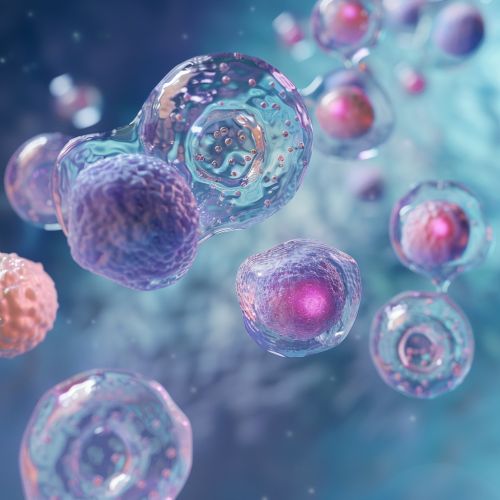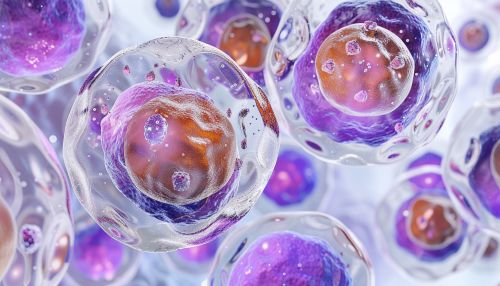Cellular Differentiation
Introduction
Cellular differentiation is the process by which a less specialized cell becomes a more specialized cell type. It is an essential process in multicellular organisms, such as humans, where it allows for the development of complex structures and systems from a single fertilized egg, or zygote. This process involves changes in gene expression, which are controlled by a network of proteins and regulatory sequences in the cell's DNA.


Process of Cellular Differentiation
Cellular differentiation begins in the earliest stages of development. The zygote divides to form a blastocyst, a hollow sphere of cells. The cells of the blastocyst are pluripotent, meaning they can differentiate into any cell type in the body. As development progresses, these cells become more specialized through a process known as determination. During determination, a cell commits to becoming a certain type of cell, such as a skin cell, a muscle cell, or a nerve cell. This commitment is irreversible and is determined by the cell's location within the developing organism and the signals it receives from its surroundings.
Mechanisms of Cellular Differentiation
The mechanisms that control cellular differentiation are complex and involve both intrinsic and extrinsic factors. Intrinsic factors include the cell's DNA and the proteins that regulate gene expression. Extrinsic factors include signals from other cells and the environment.
Gene Regulation
Gene regulation plays a crucial role in cellular differentiation. In each cell, only a subset of genes is active, or "expressed". The specific combination of active genes determines the cell's characteristics and functions. Gene expression is controlled by regulatory sequences in the cell's DNA, which can be turned on or off by proteins known as transcription factors. These proteins bind to the regulatory sequences and either promote or inhibit the transcription of the associated gene.
Signaling Pathways
Cellular differentiation is also controlled by signaling pathways, which are chains of reactions that transmit signals from the cell's surface to its interior. These signals can come from other cells or from the environment and can influence gene expression and cell behavior. There are many different signaling pathways, and they can interact with each other in complex ways to control cellular differentiation.
Types of Cellular Differentiation
There are several types of cellular differentiation, including embryonic differentiation, adult stem cell differentiation, and induced pluripotent stem cell differentiation.
Embryonic Differentiation
Embryonic differentiation is the process by which the cells of an embryo become specialized. This process begins shortly after fertilization, when the zygote begins to divide. The cells of the early embryo are pluripotent, meaning they can differentiate into any cell type in the body. As the embryo develops, these cells become increasingly specialized, eventually forming all the different tissues and organs of the body.
Adult Stem Cell Differentiation
Adult stem cells are undifferentiated cells found in many tissues and organs of the body. These cells can divide and differentiate to replace damaged or worn-out cells. The process of adult stem cell differentiation is similar to embryonic differentiation, but it is usually more limited in scope. For example, a blood stem cell can differentiate into various types of blood cells, but it cannot differentiate into a nerve cell or a muscle cell.
Induced Pluripotent Stem Cell Differentiation
Induced pluripotent stem cells (iPSCs) are adult cells that have been reprogrammed to a pluripotent state. This is achieved by introducing certain genes that are associated with pluripotency. Once reprogrammed, these cells can differentiate into any cell type in the body, just like embryonic stem cells. This technology has great potential for regenerative medicine, as it could allow for the production of patient-specific tissues and organs for transplantation.
Applications of Cellular Differentiation
Understanding and controlling cellular differentiation has many potential applications in medicine and research. For example, it could be used to generate specific cell types for transplantation, to study diseases in a dish, or to test new drugs.
Regenerative Medicine
One of the most promising applications of cellular differentiation is in regenerative medicine. By controlling the differentiation of stem cells, scientists could potentially generate any cell type in the body. These cells could then be used to replace damaged or diseased tissues, offering a potential cure for conditions such as Parkinson's disease, diabetes, and heart disease.
Disease Modeling
Cellular differentiation can also be used to study diseases. By differentiating patient-specific iPSCs into the cell type affected by a disease, scientists can study the disease in a dish. This approach can provide insights into the mechanisms of the disease and can be used to test potential treatments.
Drug Testing
Finally, cellular differentiation can be used in drug testing. By differentiating iPSCs into specific cell types, scientists can test the effects of new drugs on these cells. This approach can help to identify potential side effects and can speed up the drug development process.
